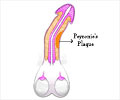Erectile dysfunction (ED) drugs like Viagra and sildenafil pose no threat to vision, say researchers.
Erectile dysfunction (ED) drugs like Viagra and sildenafil pose no threat to vision, say researchers.
According to a report in the April issue of Archives of Ophthalmology, one of the JAMA/Archives journals, two medications used to treat the disorder in men do not appear to have visual side effects when taken daily for six months, despite concerns about eye-related complications.The advent of the medications sildenafil citrate (sold as Viagra), tadalafil (sold as Cialis) and verdenafil hydrochloride (sold as Levitra) has profoundly changed the treatment of erectile dysfunction.
These medications are known as selective phodiesterase type 5 (PDE5) inhibitors because they treat erectile dysfunction by interfering with the action of the compound PDE5 on the blood vessels in the penis. However, PDE5 inhibitors may also act on similar compounds in the retina, the part of the eye that receives and transmits images.
Mild and transient blurred vision, blue-tinged vision and altered light perception have been reported by men taking these drugs, and some visual complications of long-term use have been suggested.
To reach the conclusion, William H. Cordell, M.D., of Lilly Research Laboratories, Eli Lilly and Company, Indianapolis, and colleagues conducted a randomized placebo-controlled study to assess changes in the retina among men taking tadalafil or sildenafil.
A total of 244 healthy men, some with mild erectile dysfunction, age 30 to 65 were recruited. Of these, 85 were randomly assigned to take 5 milligrams of tadalafil, 77 to take 50 milligrams of sildenafil and 82 to take a placebo daily for six months.
The men underwent comprehensive ophthalmologic examinations including electroretinography (a test to measure the electrical response of the light-sensitive rods and cones in the eye, used to detect diseases of the retina) before, during and after treatment.
Among the 194 men (79.5 percent) who completed the study, no significant differences were found between treatment and placebo groups on electroretinography, visual function tests, measurements of intraocular pressure (pressure within the eyeball) or assessments of the anatomy of the eye.
Nine participants (two in the placebo group, one in the tadalafil group and six in the sildenafil group) discontinued the study because of an adverse event, but only one of those was an ophthalmologic event (in the placebo group). No abnormalities that would be suggestive of drug toxicity were observed in any of the participants.
"There are several reasons ophthalmologists need to be acquainted with the pharmacologic profiles of PDE5 inhibitors and their potential side effects," the authors write.
"The frequency of erectile dysfunction, which is a form of peripheral vascular disease that impairs men's abilities to achieve and maintain an erection, increases dramatically with age and in the presence of cardiovascular risk factors. Therefore, many men who take PDE5 inhibitors to treat their erectile dysfunction will also be followed up by ophthalmologists for ocular disorders such as diabetic retinopathy, macular degeneration and ocular vascular disease," they added.
"Furthermore, PDE5 inhibitors can exert direct effects on the retina, and such effects probably account for many of the visual side effects such as blue-tinged vision and light sensitivity that have been reported," they conclude.
However, "our results indicate that there is no cumulative damage or effect of clinical significance for either 5 milligrams of tadalafil or 50 milligrams of sildenafil taken daily for six months," they said.
Source-ANI
MED















